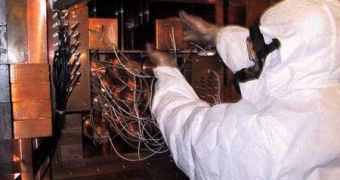Last week, physicists from the Dark Matter experiment running for the last five years under 1.4 kilometers of solid rock beneath the Gran Sasso mountain in Italy, presented their findings suggesting that dark matter particles had been discovered in the 250 kilograms sodium-iodide WIMP detector. Dark matter was first predicted in order to explain for the extra gravitational pull exerted by galaxies, and is allegedly making up to 95 percent of the whole mass of the universe.
WIMPs, or weakly interacting massive particles, thought to be the basic constituents of dark matter, were allegedly found in the first phase of the DAMA experiment as well, during the year 2000 with the help of a 100 kilogram sodium-iodide detector. WIMPs do not interact with light, but they do interact with ordinary matter through the weak nuclear force. In the course of these interactions, they emit photons of light, which may be captured and analyzed in order to determine the characteristics of the WIMPs.
Both detections seem to be seasonally correlated, with a higher concentration of WIMPs during the month of July, while the month of December experiences a minimum. According to the DAMA experiment researchers, this is due to the fact that in July the Earth follows the Sun in its orbit through the galaxy, determining an increase in WIMP wind concentration. The discovered particles have masses between 44 and 62 GeV, much lighter than the theory predicted, and there is a 99,(9) percent certainty that the claim is valid.
Nevertheless, many physicists still believe that seasonal variation has nothing to do with WIMPs or dark matter. "The DAMA announcement has had a mixed reception. No one disputes that they observe an annual modulation, but the community need to be persuaded that dark matter has anything to do with it," says ZEPLIN-III WIMP experiment, Henrique Araujo.
DAMA confirms previous predictions
Curiously enough, in the 1980s, physical theorist Katherine Freese predicted exactly the seasonal variations measured by the DAMA experiment. "The former DAMA experiment over seven annual cycles and the new DAMA/LIBRA experiment over four annual cycles show, with high confidence level, agreement with all the features expected for the presence of dark matter in the galactic halo," says DAMA experiment spokesperson Rita Bernabei.
Skeptics, on the other hand, reckon that a similar signature may be obtained through cosmic rays neutron scattering, but fail to explain why the DAMA experiment looking for such evidence found none.
Alternatively, the light emissions may be produced by particles scattering on the atomic electrons, rather of the nucleus. "ZEPELIN-III might be able to detect an electron-recoil modulation at the rates and energies reported by DAMA, but for that we need a longer run," explains Araujo. Yet another explanation regarding the measurements made with the DAMA experiment proposes that, in fact, they have been detecting axion particle, not WIMPs. The energies involved are within the modulations of the DAMA experiment, however the problem is that axion particles have not been discovered yet and they are also candidates for dark matter constituents.
Other detectors seem blind
To put things a little simpler; the explanations presented in the upper paragraphs could be wrong as well. Physicists do not doubt the claim that the DAMA experiment detected WIMP or any other form of dark matter, but the fact that DAMA is the only experiment seemingly able to see these seasonal variations. The ZEPLIN-III, COUPP and even the XENON10 experiment have failed to obtain similar results.
"For the DAMA/LIBRA result be a true dark-matter signal requires a new interaction process, or other new physics. This would be extraordinary! The particle-physics theorists have predicted many scenarios, but not this." says Alexander Murphy, also at the ZEPLIN-III experiment.
"If someone has detected dark matter, it's clearly a Nobel-prize-winning experiment. What would be best would be if they could switch off their beam, like you can in a particle detector. Unfortunately, you can't switch off WIMPs," says Richard Gaitskell, also involved in a series of WIMP experiments.

 14 DAY TRIAL //
14 DAY TRIAL //